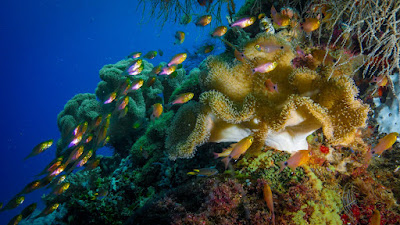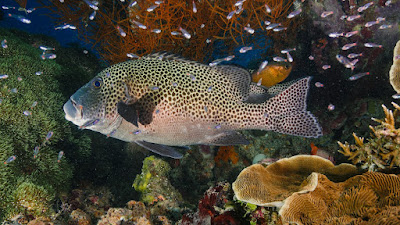Schooling Fish
Raja Ampat is home to abundant marine life and over 70% of the world's known coral species. Dive into this incredible place and you'll often be surrounded by schools of fish of all shapes and sizes. Stronger currents and deep reef drop-offs, especially at dive sites like Blue Magic and Cape Chestnut, attract schools of fish that appear to be floating in the currents away from the reef.
Surrounded by countless fish, it can be terrifying to identify them all. We've put together a guide on what and where to expect in this diving paradise. When you start your descent on a dive, you will most likely be surrounded by fusiliers.
These small blue-and-yellow pelagic fish are often found in shallow areas of coral reefs feeding on plankton. Occasionally, you may see large schools of red-toothed clownfish leaping to the surface, disappearing from their bright blue color and returning to deep water.
Often you can even spot blue shapes and turbulent water due to movement from the surface. Like fusiliers, they feed mainly on plankton and krill near the surface. Juvenile long-finned batfish have also been sighted in small groups near the surface, and groups of these strange fish often follow groups of divers from descent to accent.
Raja Ampat is a great destination for scuba divers, but snorkelers can also get a taste of these impressive schools of fish. Local piers near popular dive sites are the most impressive snorkeling bases imaginable.
The shallow waters of Raja Ampat are teeming with schools of fish. There are also many interesting sightings in the deeper waters.
Besides barracuda, which inhabit deeper waters, many gamefish are found in large groups. Giant trevally, yellowfin tuna and snapper, just to name a few. These are truly incredible schools of fish, but it is important for divers to keep safety in mind if they want to see these gamefish.
As a general rule of thumb, the stronger the current in Raja Ampat, the more , you can see more fish. Diving in these currents is safe, but safe diving procedures should always be followed when diving with a trained professional. Also, safety should never be neglected due to potential sightings.
The most interesting fish schools in Raja Ampat are the large schools of groupers and giant sweetlips found in the deep sea. Both species of fish grow very large, with giant sweetlips reaching 1m in length and groupers even larger.
Both species prefer deep waters, where rocks and reef structures are used to protect against currents and apex predators that patrol the reef system. Swimming over the rock formations is an impressive sight just to see a group of 20 giant Sweetlips swimming lazily beneath it.


Post a Comment for "Schooling Fish"